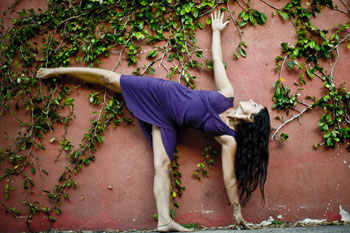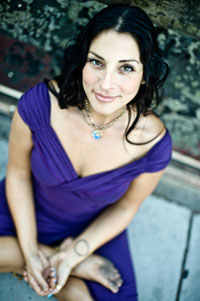The Inner Journey From Pain To Bliss, The Outer Journey From Practice To Giving Back
Psalm Isadora’s exposure to Yoga took place fifteen years ago when a friend invited her to a Yoga class at a gym. At the time, she was suffering from back pain due to the ravaging effects of chronic stress and chronic disease. Although she admits to experiencing a glimpse of something hopeful in the class, along with an intuitive hit that if she did Yoga regularly, life would somehow just work better, Yoga practice and philosophy just felt weird to her. “When the teacher talked about Yoga being ‘transformational,’ I didn’t know what she meant,” Psalm remembers. At the time, she was a single mother who wasn’t quite ready to take on Yoga practice, but with that first introduction, an impression was made, a samskara implanted. It was an impression that would have a pivotal effect on who Psalm is now.
“Yoga saved my life.” Psalm is frank and matter-of-fact when she recalls the experience of hitting rock bottom. A diagnosis of bipolar disorder, attempts to find balance through pharmaceutical medications and nonpharmaceutical recreational drugs, and pain and overwhelming anxiety created a situation in which Psalm says that her life just didn’t work. She felt as though there were a pillar of fire constantly on her back, a burning torch fueled by multiple levels of disease and discomfort. “I would go into pockets of euphoric bliss and then crash land into a world that I thought was ugly and full of suffering and pain and I didn’t know how to reconcile it.” Yet she remembered her experience of Yoga and she made a sankalpa, a resolution to dedicate herself to a daily practice. “I knew if I did Yoga every day, I would be much stronger.”
Through regular practice, she felt she could find a way feel connected to God, to move her body and breathe. She says that it was this complete surrender that saved her life. It was so powerful that she dedicated her renewed life to both the practice and teaching of Yoga; she wanted to help others feel that same connection.
Psalm Isadora counts study with Saul David Raye and a mentorship with Master Zi in Santa Monica as important influences. Practice in Los Angeles awakened in her what she describes as an inexplicable desire to travel to India to continue her study. Repeated trips led her first to Yogiraj Swami Samartanananda Sarasvati from the Bihar School and then, when she was searching for a Guru, to the Sri Vidya Tantra teacher Guru Sri Amritananda, who comes from what Psalm describes as an old form Tantra lineage.
The Tantric goddess worship was a calling. Growing up in a born-again Christian household, in a spiritual community that embraced ecstatic dance, yet with a God always described as masculine, she was drawn to the complementary feminine qualities of the goddess who encourages the joyful experience of the divine in this world and this life. Psalm describes her attraction to Tantra, “Wouldn’t God want me to appreciate the life that I have? It’s not just about dying and going to heaven. All of the experiences we have in this life are the path to God too.”
Psalm knew she had found her teacher when she heard Guru Sri Amritananda’s three tenets of life:
- Be comfortable being myself all the time.
- Love my family and the whole world the same as my family.
- Have a peaceful place to live.
For Psalm Isadora, this was not only liberating, it was everything. “That’s enlightenment as far as I’m concerned. If I’m comfortable with myself, then all the things I’m searching for can be expressed. If I’m not comfortable, then that creates a lot of snags in my internal and external relationships.” I It helped that Psalm felt completely accepted by her teacher, allowing her to address the things in her life and herself, she had not been able to deal with previously. “Over time, the unconditional acceptance has allowed me to surrender and to take responsibility for my own healing and my own choices and patterns.”
This sense of responsibility has led to her initiating a series of seva efforts, commitments to selfless service. Seeing poverty and destitution and wanting to give back to India, the country she felt opened its heart to her was the inspiration. While leading a teacher training program in Goa in 2008, not only did half of the cost of tuition go directly into organizing Yoga classes and private sessions for area residents who would otherwise not have access to the practice, Psalm and students worked directly with people offering the teachings. She shares an example, “Last year, a middle-aged Indian man who owned a tailor shop and had back pain came in and did Yoga. Not only did the pain go away, through Yoga, he said he could feel God in his body and meditate more.”
As I write this, Psalm Isadora is getting ready to return to India in January, 2010, to Guru Sri Amritananda’s ashram in Andhra Pradesh, where students in her teacher training program and intensive will have the opportunity to immerse themselves in traditional practices such as morning fire puja (ceremony). She’s already planning the service project – a collaboration with the ashram where she and other students will offer classes including job skills and empowerment training, with Yoga woven in, of course. As Psalm puts it, “I want to give back something that brought me joy.” And to hear her tell it, Yoga brought more than joy; Yoga saved her life.
Felicia Tomasko has spent more of her life practicing Yoga and Ayurveda than not. She first became introduced to the teachings through the writings of the Transcendentalists, through meditation, and using asana to cross-train for her practice of cross-country running. Between beginning her commitment to Yoga and Ayurveda and today, she earned degrees in environmental biology and anthropology and nursing, and certifications in the practice and teaching of yoga, yoga therapy, and Ayurveda while working in fields including cognitive neuroscience and plant biochemistry. Her commitment to writing is at least as long as her commitment to yoga. Working on everything related to the written word from newspapers to magazines to websites to books, Felicia has been writing and editing professionally since college. In order to feel like a teenager again, Felicia has pulled out her running shoes for regular interval sessions throughout Southern California. Since the very first issue of LA YOGA, Felicia has been part of the team and the growth and development of the Bliss Network.


